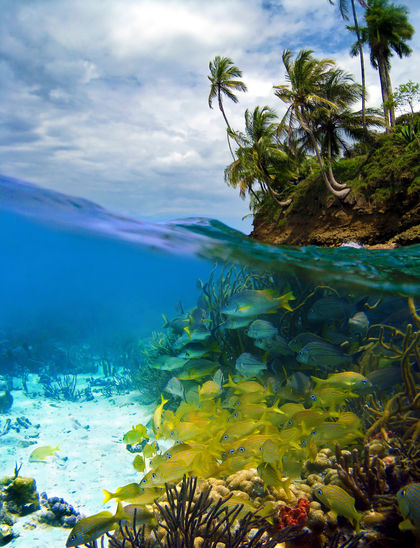PANAMA

Republic of Panama República de Panamá
CAPITAL : Panamá (Panama City)
FLAG : The national flag is divided into quarters. The upper quarter next to the staff is white with a blue star; the upper outer quarter is red; the lower quarter next to the staff is blue; and the lower outer quarter is white with a red star.
ANTHEM : Himno Nacional, beginning "Alcanzamos por fin la victoria" ("We reach victory at last").
MONETARY UNIT : The balboa ( B ) of 100 centésimos is the national unit of account. Panama issues no paper money, and US notes are legal tender. Panama mints coins of 0.05, 0.10, 0.25, 0.50, 1 and 5 balboas which are interchangeable with US coins. B 1 = $1.00 (or $1 = B 1.00).
WEIGHTS AND MEASURES : The metric system is official, but British, US, and old Spanish units also are used.
HOLIDAYS : New Year's Day, 1 January; Martyrs' Day, 9 January; Labor Day, 1 May; National Revolution Day, 11 October; National Anthem Day, 1 November; All Souls' Day, 2 November; Independence from Colombia, 3 November; Flag Day, 4 November; Independence Day (Colón only), 5 November; First Call of Independence, 10 November; Independence from Spain, 28 November; Mother's Day and Immaculate Conception, 8 December; Christmas, 25 December. Movable religious holidays are Shrove Tuesday and Good Friday.
TIME : 7 AM = noon GMT.
LANGUAGES
Spanish, the official language of Panama, is spoken by over 90% of the people, but English is a common second language, spoken by most Panamanian professionals and businesspeople. The Amerindians use their own languages. Many Panamanians are bilingual.
LOCAL GOVERNMENT
Panama is divided into nine administrative provinces, each headed by a governor appointed by the president, and one Amerindian territory. The provinces are subdivided into 67 municipal districts, each of which is governed by a mayor and a municipal council of at least five members, including all that district's representatives in the National Assembly. There are 511 municipal subdistricts in all.
ARMED FORCES
The Panamanian Defense Force disappeared with the US intervention in 1989. The National Police Force numbers approximately 11,800, supported by a maritime service (400 staff, 14 patrol boats) and air service (400 staff, 33 aircraft and helicopters). In 1999 Panama spent $128 million on defense or1.3% of GDP.
INTERNATIONAL COOPERATION
Panama is a charter member of the UN, having joined on 13 November 1945, and participates in CCC, ECLAC, FAO, G-77, IADB, IAEA, IBRD, ICAO, ICFTU, ICRM, IDA, IFAD, IFC, IFRCS, ILO, IMF, IMO, Interpol, IOC, IOM, ISO (correspondent), ITU, LAES, LAIA (observer), NAM, OAS, OPANAL, OPCW, PCA, RG, UN, UNCTAD, UNESCO, UNIDO, UPU, WCL, WFTU, WHO, WIPO, WMO, WToO, and WTrO.
DEPENDENCIES
Panama has no territories or colonies.
BIBLIOGRAPHY
Conniff, Michael. Black Labor on a White Canal: Panama. Pittsburgh, Pennsylvania: University of Pittsburgh Press, 1985.
Flanagan, E. M. Battle for Panama: Inside Operation Just Cause. Washington, D.C.: Brassey's (US), Inc., 1993.
Greene, Graham. Getting to Know the General. New York: Simon and Schuster, 1984.
Guevara Mann, Carlos. Panamanian Militarism: A Historical Interpretation. Athens, Ohio: Ohio University Center for International Studies, 1996.
Health in the Americas, 2002 edition. Washington, D.C.: Pan American Health Organization, Pan American Sanitary Bureau, Regional Office of the World Health Organization, 2002.
Hedrick, Basil C., and Anne K. Hedrick. Historical Dictionary of Panama. Metuchen, N.J.: Scarecrow, 1970.
Hogan, J. Michael. The Panama Canal in American Politics: Domestic Advocacy and the Evolution of Policy. Carbondale: Southern Illinois University Press, 1986.
LaFeber, Walter. The Panama Canal: The Crisis in Historical Perspective. New York: Oxford University Press, 1989.
Major, John. Prize Possession: The United States and the Panama anal, 1903–1979. New York: Cambridge University Press, 1993.
McCullough, David G. The Path Between the Seas: The Creation of the Panama Canal, 1870–1914. New York: Simon and Schuster, 1977.
Meditz, Sandra W., and Dennis M. Hanratty (eds.). Panama: A Country Study. 4th ed. Washington, D.C.: Library of Congress, 1989.
Moffet, George D. The Limits of Victory: The Ratification of the Panama Canal Treaties. Ithaca, N.Y.: Cornell University Press, 1985.
Richard, Alfred Charles. The Panama Canal in American National Consciousness, 1870–1990. New York: Garland, 1990.
US Department of State. The Panama Canal Treaties and Associated Agreements and Documents. Washington, D.C.: Government Printing Office, 1979.
Watson, Bruce W., and Peter G. Tsouras (eds.). Operation Just Cause: The U.S. Intervention in Panama. Boulder, Colo.: Westview Press, 1991.
Zencey, Eric. Panama. New York: Farrar, Straus, and Giroux, 1995.
Zimbalist, Andrew S. Panama at the Crossroads: Economic Development and Political Change in the Twentieth Century. Berkeley, Calif.: University of California Press, 1991.